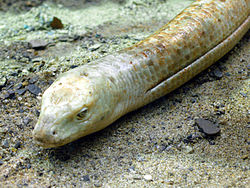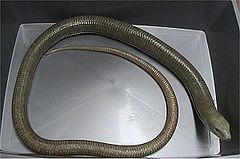- Sheltopusik
-
Scheltopusik 
Scientific classification Kingdom: Animalia Phylum: Chordata Class: Reptilia Order: Squamata Family: Anguidae Subfamily: Anguinae Genus: Pseudopus Species: P. apodus Binomial name Pseudopus apodus
Pallas, 1775Synonyms Ophisaurus apodus
two schetopusiks fighting
The Scheltopusik or European Legless Lizard (Pseudopus apodus) is a large glass lizard found from southern Europe to Central Asia. Its common name comes from the Russian желтопузик (literally yellow-bellied). It was previously in the genus Ophisaurus but has been placed in its own genus Pseudopus.
Contents
Description
This lizard can reach a length of 135 cm. It has a tan coloration, paler on the ventral surface and the head, with a ring-like/segmented appearance that makes it look like a giant earthworm, with a distinctive fold of skin down each side called a lateral groove. Small (2 mm) rear legs are sometimes visible near the cloaca. Though their legs are barely discernible, they can be easily distinguished from a snake by their ears, their eye lids, and ventral scales.
Habitat and behaviour
This lizard likes open country such as short grassland or sparsely wooded hills. The scheltopusik consumes arthropods, and small mammals. Snails and slugs appear to be its favorite prey, which may explain why it is particularly active in wet weather, although it prefers a dry habitat.
Due to its size, the scheltopusik tends to respond to harassment by hissing, biting, and musking. It is less likely to drop off its tail than some other species that display caudal autotomy. However, these occasional displays of caudal autotomy are responsible for the name "glass lizard" (or "glass snake"). The released tail may break into pieces, leading to the myth that the lizard can shatter like glass and reassemble itself later. In reality, if the tail is lost, it grows back slowly, but is shorter and darker.
In captivity
They are frequently available in the exotic pet trade, though rarely captive bred. They do not typically tolerate a large amount of handling, but they adapt to captivity well, feeding on crickets, meal worms, small mice, eggs, snails or pieces of meat which they even accept from a keeper´s tweezers once they become used to captivity. They make hardy captives, capable of living up to fifty years.
Approxiamtely 10 weeks after mating, the female lays about 8 eggs which she hides under bark or a stone and often guards them. The babies hatch after 45 – 55 days. They average about 15 cm long and usually start to eat after four days.
References
"The Scheltopusik, Pseudopus [Ophisaurus apodus: Natural History and Care"]. Cyber Lizard U.K.. 2003-09-28. http://www.cyberlizard.plus.com/pseudopus_apoda.htm. Retrieved 2008-01-19.
"Scheltopusik Care Sheet and Information". Western New York Herpetological Society. 2008. http://www.wnyherp.org/care-sheets/lizards/sheltopusik.php. Retrieved 2008-01-19.
Kaplan, Melissa (1997). "Glass Lizard - Glass Snake - Legless Lizard". Melissa Kaplan's Herp Care Collection. http://www.anapsid.org/legless.html. Retrieved 2008-01-19.
"European Glass Lizard". Wild Natures. September 2006. http://www.wild-natures.com/pseudopus_apodus.html. Retrieved 2008-01-19.
"Giant Legless Lizard". Central Pets. 2008-01-19. http://www.centralpets.com/animals/reptiles/lizards/lzd2700.html. Retrieved 2008-01-19.
- List of reptiles of Italy
External links
Categories:- Anguids
- Legless lizards
- Reptiles of Europe
- Reptiles of Asia
- Animals described in 1775
Wikimedia Foundation. 2010.

